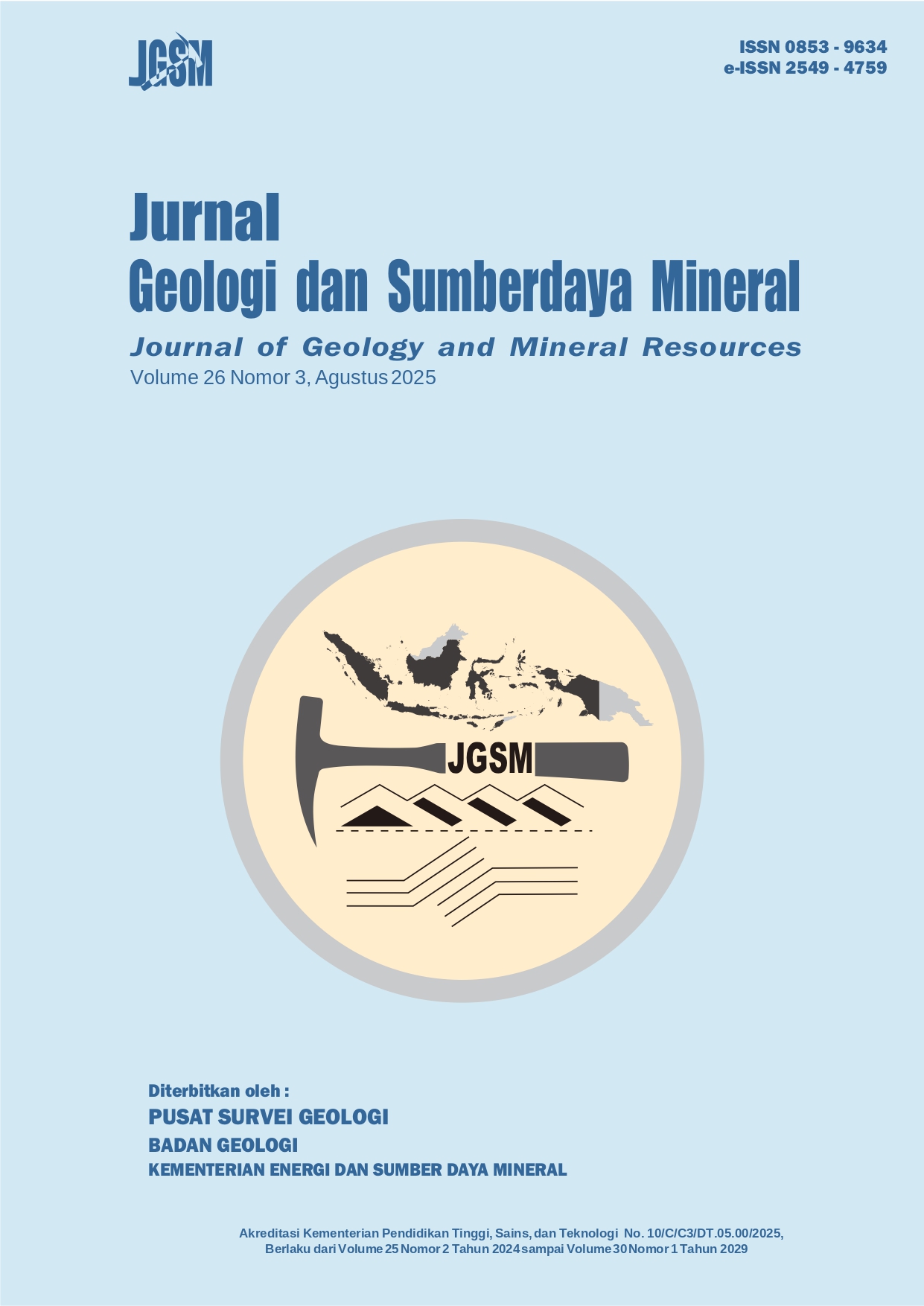Geologi Daerah Iha – Luhu, Kecamatan Huamual, Kabupaten Seram Bagian Barat, Provinsi Maluku
DOI:
https://doi.org/10.33332/jgsm.geologi.v26i3.941Abstract
Daerah Iha – Luhu terletak di Provinsi
Maluku tepatnya pada wilayah Kecamatan Huamual
Kabupaten Seram Bagian Barat. Wilayah penyelidikan
berada pada koordinat 128o0’35” s.d 128o02’42” Bujur
Timur dan 3o20’40” – 3o22’05” Lintang Selatan. Tujuan
dilakukannya pemetaan geologi pada wilayah ini adalah
untuk mendapatkan keadaan geologi wilayah penelitian
khususnya menyangkut kondisi geomorfologi, stratigrafi
serta struktur geologi. Metodologi penelitian menggunakan
studi literatur, penelitian lapangan, analisa laboratorium
serta menggunakan peta Digital Elevation Model
(DEM). Berdasarkan kegiatan penelitian bahwa kondisi
geomorfologi di wilayah penelitian mencakup dua satuan
morfologi yang terdiri dari satuan dataran rendah dan satuan
perbukitan rendah berlereng sangat landai – curam. Tatanan
stratigrafi di Iha – Luhu terbagi menjadi tiga satuan dimana
terdiri atas satuan filit kuarsa - muskovit, satuan meta
batupasir kuarsa – muskovit, dan endapan aluvium. Struktur
geologi yang berkembang merupakan lipatan antiklin di
utara timur laut Bukit Tembaga. Hal ini ditunjukkan dengan
kemiringan foliasi batuan sebesar 25o - 64o yang berarah
timur laut – barat daya dengan sudut kemiringan landai -
curam. Secara umum struktur sesar dan liniasi yang berarah
timur laut – barat daya dan tenggara – barat laut terbentuk
pada periode waktu yang sama.
Kata kunci: Iha - Luhu, pemetaan geologi, geomorfologi,
stratigrafi, struktur geologi.
Abstract
Iha – Luhu area is located in Maluku Province,
precisely in the Huamual District, Western Seram Regency.
Geographically, it is occupied at coordinates 128o0’35”
to 128o02’42” East Longitude and 3o20’40” – 3o22’05”
South Latitude. The purpose of geological mapping in
this area is to obtain geological conditions of the research
area regarding geomorphological conditions, stratigraphy
and geological structures. The research methodology used
literature studies, field research, laboratory analysis and a
Digital Elevation Model (DEM) map. Based on research
activities, the geomorphological conditions in the research
area include two morphological units consisting of lowland
units and low hill units with very gentle to steep slopes.
The stratigraphic unit in Iha – Luhu is divided into three
units consisting of quartz – muscovite meta-sandstone
units, quartz – muscovite phyllite units and alluvium.
The geological structure that developed in this area is an
anticline fold in the northeast of Bukit Tembaga. This is
indicated by a 25o– 64o slope of rock foliation that trends
northeast-southwest with a gentle to steep slope angle. In
general, fault structure and lineation trending NE-SW and
SE-NW are formed in the same time period.
Keywords: Iha – Luhu, geological mapping, geomorphology,
stratigraphy, geology structure.
Keywords: Iha – Luhu, geological mapping, geomorphology,
stratigraphy, geology structure.
Downloads
Downloads
Published
Issue
Section
License
Copyright (c) 2025 Herfien Samalehu, Arifudin Idrus, Nugroho Imam Setiawan

This work is licensed under a Creative Commons Attribution-NonCommercial 4.0 International License.
Authors who publish articles in Jurnal Geologi dan Sumberdaya Mineral (JGSM.Geologi) agree to the following terms:
- Authors retain copyright of the article and grant the journal right of first publication with the work simultaneously licensed under a CC-BY-NC or The Creative Commons Attribution–ShareAlike License.
- Authors are able to enter into separate, additional contractual arrangements for the non-exclusive distribution of the journal's published version of the work (e.g., post it to an institutional repository or publish it in a book), with an acknowledgment of its initial publication in this journal.
- Authors are permitted and encouraged to post their work online (e.g., in institutional repositories or on their website) prior to and during the submission process, as it can lead to productive exchanges, as well as earlier and greater citation of published work (See The Effect of Open Access)










